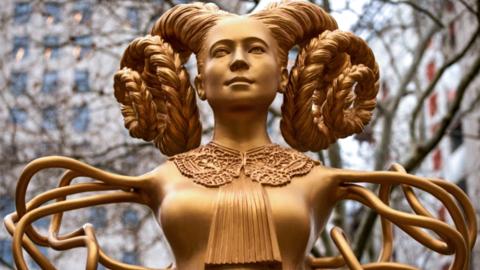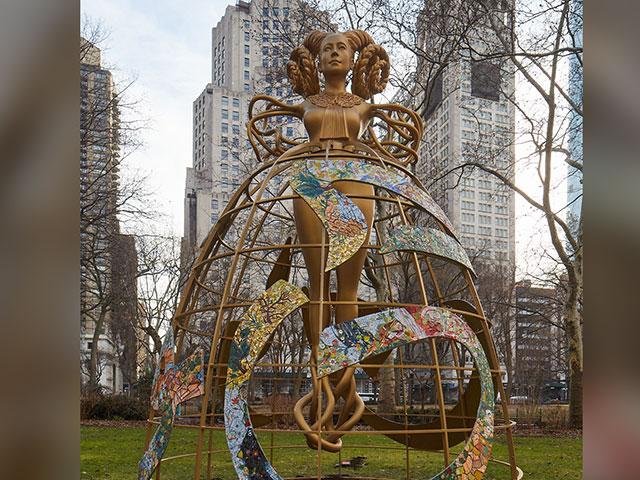
Texas Right to Life Calls on University to Cancel 'Satanic Abortion Idol' Display
A pro-life group is calling for a Texas university to drop its plans to publicly display "a golden statue with satanic imagery" that's meant to honor abortion and the late Supreme Court Justice Ruth Bader Ginsburg.
Texas Right to Life released a petition earlier this month, asking the University of Houston (UH) to keep the statue out of Texas, calling it a "satanic abortion idol."
The 18-foot golden female sculpture with hair braided like spiraling horns is called "Witness." It debuted in New York's Madison Square Park last year. The sculpture includes a hoop skirt inspired by the stained-glass dome of the nearby courthouse, symbolizing the need to "break the legal glass ceiling," according to The New York Times.
The statue has arms like tentacles and features a lace collar like Justice Ginsburg often wore with her robes.
Written on the sculpture is the word "havah," which the artist said means "air" or "atmosphere" in Urdu and "Eve" in Arabic and Hebrew, the outlet reported.
According to the Art Newspaper, artist Shahzia Sikander interpreted the term 'havah' as meaning "to breathe, to add air, to change a narrative, to add some space," she says. "Eve is also the first law-breaker, right?"
Co-commissioned by Madison Square Park Conservancy and the Public Art of the University of Houston System (Public Art UHS), the Witness statue will be on display at the Cullen Family Plaza at UH from Feb. 28 through the end of October.

Artist Shahzia Sikander's sculpture named "Witness." (Photo courtesy: Madison Square Park)
"Disobedience to God certainly should not be esteemed by society, much less lauded with a statue," Texas Right to Life said. "On the contrary, art should reflect truth, goodness, and beauty: three timeless values that reveal the nature of God. Art cannot have beauty without truth. Art cannot have truth without goodness."
"A statue honoring child sacrifice has no place in Texas," the pro-life group added as they invited the public to protest peacefully at the UH on Feb. 28 when the exhibit is scheduled to open.
***Please sign up for CBN Newsletters and download the CBN News app to ensure you keep receiving the latest news.***
 In a statement, the university defended its decision to bring the statute to the Lone Star State.
In a statement, the university defended its decision to bring the statute to the Lone Star State.
"Displaying a temporary work from an artist is never meant to be a celebration of the artist or his/her work but to simply provide a platform for artistic expression that encourages critical reflection and exploration of important issues," the school said. "A part of student education is to understand that art can evoke diverse interpretations and emotions and that we must find ways to engage in constructive dialogue."
According to UH's fact sheet, the artwork portrays "cultural interconnectedness."
"The allegorical female form's arms and legs resemble intertwined tree roots. According to the artist, the form is self-rooted and 'can carry its roots wherever it goes,' making it able to have roots across cultures, places, and times. It also explores issues of being part of a diaspora, having to move around from place to place and how that can affect one's identity," the fact sheet explained.
"The sculpture has braids shaped like ram horns, representing the unification of disparate strands. Ram horns have significance in Judaism, Christianity, and Islam as well as Central and South Asian beliefs, often associated with power and valor. The artist has said the braids link to one of her paintings that represents the courage, fluidity, and resilience of the feminine," the description continued.
As CBN News reported in January 2023, the female sculpture's eight-foot sister statue called "Now" was installed on top of the Courthouse of the Appellate Division, First Department of the Supreme Court of the State of New York, in New York City. It was placed alongside other sculptures depicting historical, religious, and other legendary lawgivers, all of them men.
Sikander said at the time the work was called "Now" because it was needed "now," at a time when women's reproductive rights were allegedly under siege after the U.S. Supreme Court overturned the ruling that had invented a federal right to abortion.



